Whether you’re hitting the pavement or sprinting on one of the best treadmills money can buy, running has been shown to improve cardiovascular health, create stronger bones, lower resting heart rate, improve VO2 max, delay memory loss as we age, and potentially stave off the risk of developing dementia. (1)(2)(3) That’s a pretty promising list of benefits, and if you need a reason to lace up and get moving, you’ll find one there.
We’ve tried and tested more than 40 of the most popular treadmills on the market, and if you’ve combed through some of our other roundups, you’re sure to have stumbled across some of the best folding treadmills on the market. However, we’re leaving those treadmills in the dust for this piece. While you can save space and money with a folding treadmill, the trade-off is often the stability and quality of the equipment. Non-folding treadmills will require a dedicated space in your home, but they’ll last longer and provide a more stable workout experience as you hit your stride. Here are our picks for the best non-folding treadmills.
The Best Non-Folding Treadmills
- Best Non-Folding Treadmill Overall: NordicTrack Commercial X22i
- Best Motorless Non-Folding Treadmill: Assault Runner Pro
- Best Versatile Non-Folding Treadmill: Sole ST90
- Best Non-Folding Treadmill for Athletes: TrueForm Runner
- Best Non-Folding Treadmill with Classes: Peloton Tread
- Best Non-Folding Walking Treadmill: Egofit Walker Pro Under Desk Treadmill
How We Tested the Best Non-Folding Treadmills
The surest way to find the best non-folding treadmills is to run on every treadmill you can get our hands on. Knowing that’s a lofty ask, the team here at BarBend did the work for you. Our roster of seasoned athletes, marathon runners, and certified personal trainers has tried and tested over 40 of the most popular treadmills on the market. We narrowed our list of the best non-folding treadmills down to six picks by scoring each machine from 1 (not so good) to 5 (that’s really good) in the following categories:
- Durability
- Customizations
- Adjustability and ergonomics
- Footprint and portability
- Delivery and setup
- Workout experience
- Tech capabilities
- Conveniences
- Dynamic programming
- Customer reviews
- Value
- Warranty, financing, and returns
Those devoted to building the best home gym know their mission won’t be complete without a top-of-the-line treadmill. When curating the non-folding treadmills on this list, we took into account tech features that would keep users engaged and speed and incline adjustments for those needing the ability to push their training. We also sought to include motorized and non-motorized options. We kept a focused eye on the price, and used our scores for each category to help us rate the value of each product.
Our team appraised features while we tested the equipment, taking notes on everything from how the deck felt and how difficult it was to make adjustments mid-workout to how entertaining we found the programming. We also built each treadmill out of the box so that we could relay how easy or difficult that process was. Most importantly, though, our team spent hours on these machines to give you our honest opinion on each product.
The first thing our testers considered while building this list was the available running surface. We opted for decks with 20-inch by 60-inch running surfaces so that users of varying heights and strides could fit comfortably. When a deck was shorter than this, we made sure to mention it and explain why we still thought it was still a good choice. We also explained what type of user would be best for each treadmill, from those looking to spend dedicated time going the distance to those looking to break up their workday by logging some steps.
Best Overall Non-Folding Treadmill: NordicTrack Commercial X22i
NordicTrack X22i Treadmill
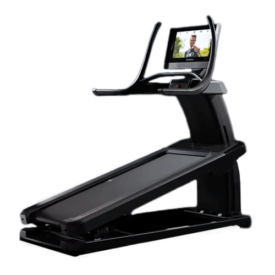
NordicTrack X22i Treadmill
The NordicTrack Commercial X22i is built for those who want to climb. The machine inclines up to 40 percent and declines down to -6 percent. It features a Sled Push option where you can power the belt with your own leg drive, and it has a 22-inch touchscreen display where you can follow your workout and take iFit classes.
Specs
- Price: $3,499
- Dimensions: 72.5″ H x 70″ L x 39″ W
- Weight: 417lbs
- Max Speed: 12mph
- Max Incline: -6% up to 40%
- Max User Capacity: 300lbs
Pros
- This durable treadmill has a 12 miles per hour max speed and a jaw-dropping 40 percent incline.
- This treadmill is IFIT-compatible, allowing you access to more than 16,000 cardio, strength, and mobility classes.
- The 22-inch by 60-inch running deck is 4 inches wider and 5 inches longer than the industry standard.
Cons
- There’s a high step-up height to get onto the running belt, which might be difficult for some users.
- At 417 pounds, this is a heavy machine that’s difficult to move around.
- This treadmill might not be suitable for small spaces and low ceilings.
The NordicTrack X22i, our pick for the overall best non-folding treadmill, was built with serious runners in mind. We rated it a perfect 5 out of 5 in categories like durability, adjustability, conveniences, and tech capabilities. A smart treadmill, it comes with a large 22-inch screen, IFIT app integration, impressive incline capabilities, plenty of space to run, and a stable frame.
This thing is the Mount Everest of treadmills. “There are 40 incline levels – more than what we’ve seen on other treadmills we’ve tried, which typically allow for 10 levels.” said our tester, who scored its customizations a 5 out of 5. “You’re also getting 6 levels of decline.” No matter the heights you want to climb or descend, the NordicTrack X22i provides. (One note: You’ll be about 25 inches off the ground at the 40 percent incline, so make sure you’ve got enough headroom in your gym.)
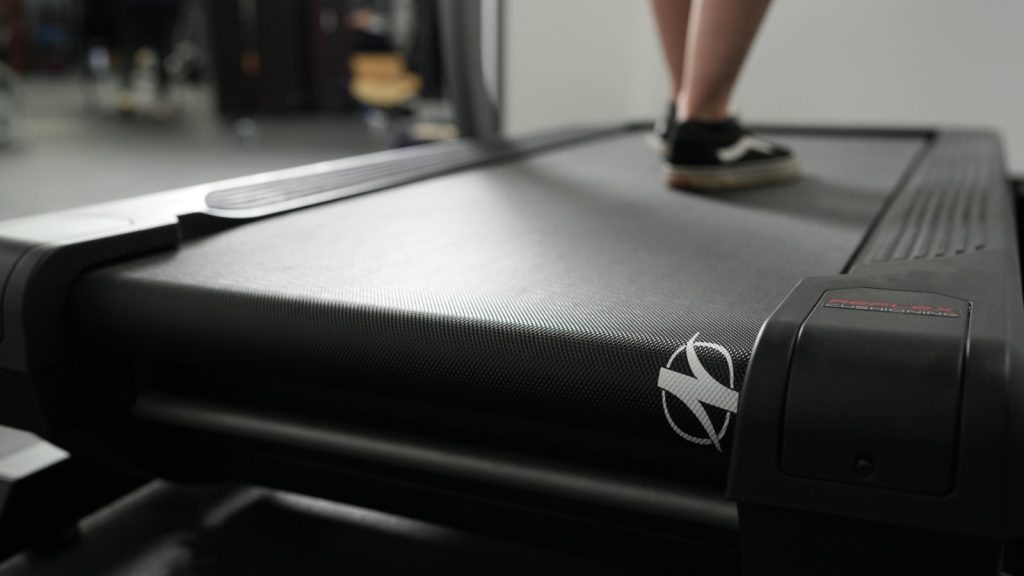
You’re getting a generous 22-inch by 60-inch running deck that’s 5 inches longer and 4 inches wider than the industry standard. “This size is exactly what you want if you have a longer stride or are tall,” our tester, a certified CrossFit coach, noted. “The 4.0 CHP motor is outstanding, it’s a better motor than what we generally recommend for long-distance runners.” This workhorse of a motor will keep your treadmill running smoothly through all of your hill sprints and Fartlek training.
We’re IFIT stans here at BarBend, and this treadmill comes compatible with the popular app. With thousands of on-demand classes, both in-studio and on scenic trails, “IFIT is a strong competitor to Peloton,” said our tester, who scored the X22i’s dynamic programming a 5 out of 5. We love the AutoAdjust feature that allows IFIT to make adjustments to speed and incline based on coaching or programming. After your free 30-day trial ends, the app will cost an additional $39 a month or $180 a year.
Footprint and setup both scored a 3 out of 5. “It’s 417 pounds, so you’ll need help setting it up. I also wouldn’t recommend this for apartments since it takes up lots of space,” our tester said. There’s also a high step up to get onto the treadmill once you’re ready to run. The running deck is about 12.5 inches off the floor when at a 0 percent incline, so users with balance issues may want to take note.
Read our full NordicTrack X22i Treadmill Review.
Best Motorless Non-Folding Treadmill: Assault Runner Pro
AssaultRunner Pro
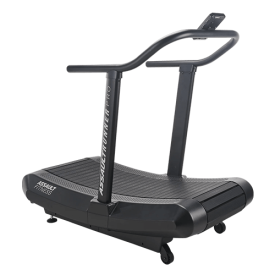
AssaultRunner Pro
The AssaultRunner Pro is a durable, motorless treadmill that can be great for athletes wanting full control of their training intensity. The durable frame boasts a 350-pound weight capacity, and the included display console is easy to read, albeit simpler in nature.
Specs
- Price: $2,999
- Dimensions: 64″ H x 69.7″ L x 33.1″ W
- Weight: 374lbs
- Max Speed: Unlimited
- Max Incline: 0%
- Max User Capacity: 350lbs
Pros
- Studies show exercise on manual treadmills can result in more burned calories than on an electric treadmill.
- Since it requires no outlet and has transport wheels, this treadmill can easily be moved from room to room.
- This model is nearly identical to the Assault Runner Elite, but comes with a price tag that’s $1,000 less.
Cons
- You can’t adjust the incline or decline on this treadmill.
- This treadmill is a BIG BOY at 374 pounds, about 125 to 175 pounds heavier than the average treadmill we’ve tried.
- There are limited tech abilities and the LCD display provides only basic stats.
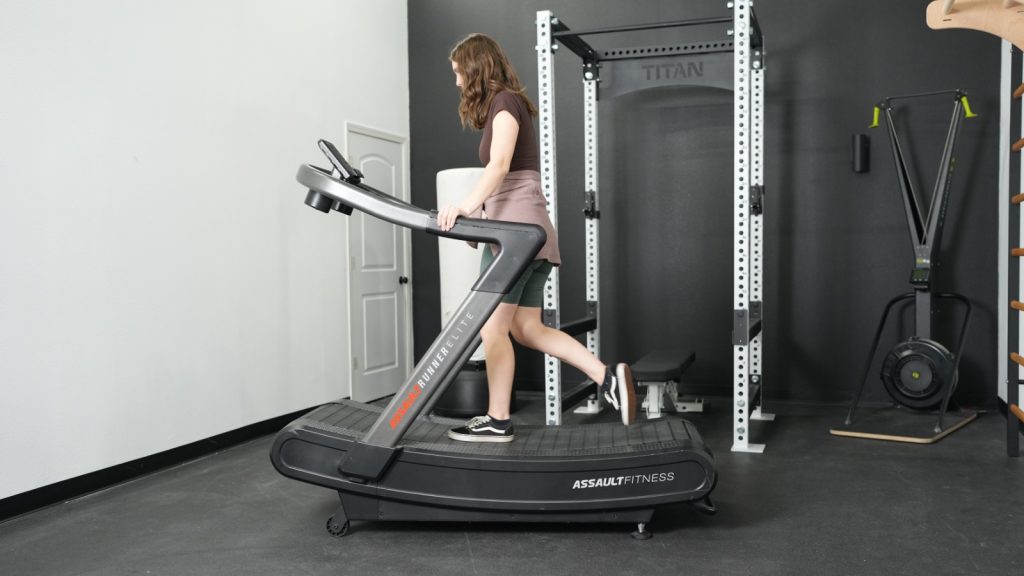
Motorless treadmills provide an experience that most closely resembles how we run on the ground, with the ability to accelerate and decelerate quickly. It also takes more effort than a motorized treadmill, as it’s on the user to make the belt move, which means greater cardiometabolic demand and more calories burned. (4) The Assault Runner Pro is priced at $2,999, an affordable curved treadmill when compared to other models that can range from $4,000 up to $7,000.
In our Assault Runner Elite Treadmill review, we noted that, outside of the look, warranty, and max user weight, there are few differences between the Pro and this upgraded version. The Assault Runner Pro has a max user weight of 350 pounds — 50 pounds less than the Elite — and the belt warranty lasts for 150,000 miles, while the Elite has a lifetime warranty. Our tester even noted, “The Pro model is super similar to the Assault Runner Elite, but it’s about $1,000 less expensive.” They’re like fraternal twins, where maybe one is a little more water-resistant (the Elite), but you won’t notice who’s who most of the time.
Since non-motorized treadmills require you to power the machine, you’re going to want a spacious belt that allows for a long stride. With a running surface of 17 inches by 62 inches and a solid steel frame, you’ll have the space and stability to sprint like nobody’s watching.
Scoring its adjustability and ergonomics a 4 out of 5, our tester observed, “There’s a bit of a learning curve, it took a few uses to figure out where on the belt I should be for a smooth run.” Also, the belt is heavy, which our tester noticed made it more difficult to go at a slower pace.
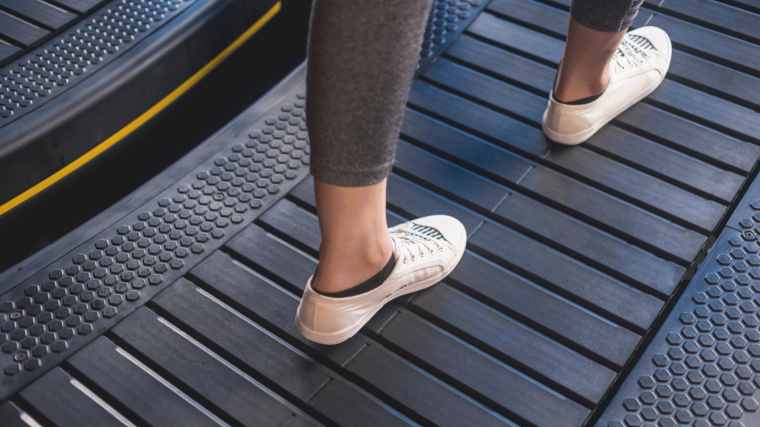
You won’t find many gizmos and gadgets on the Assault Runner Pro. You will, however, have access to onboard programs and basic data points from your workout, including speed, time, calories, watts, pace, and heart rate. There’s also Bluetooth and ANT+ connectivity, so you can link up with an app like Zwift or even the Assault Fitness App, which allows you to complete challenges and compete with friends. Tech capabilities scored a 3.5 out of 5. “The monitor is good, it can connect to your heart rate monitor, but outside of that, the tech is fairly limited,” our tester said.
Best Versatile Non-Folding Treadmill: Sole ST90
Sole ST90
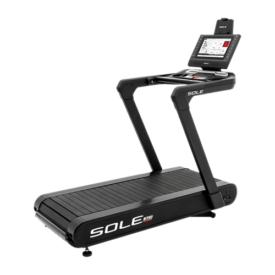
Specs
- Price: $3,799.99
- Dimensions: 66″ H x 82.5″ L x 38″ W
- Weight: 326lbs
- Max Speed: 12mph
- Max Incline: 15 levels
- Max User Capacity: 400lbs
Pros
- This versatile machine operates as both a motorized and a manual treadmill.
- The console comes preloaded with apps like Netflix and Hulu, so you can catch up on murder shows while working on your fitness.
- A wireless charging doc keeps your phone charged during runs.
Cons
- The slat belt design has some safety concerns, and users will want to keep kids and pets away.
- There are transport wheels, but no handlebar to hold onto when you tip the machine up to move it.
- The deck isn’t super bouncy or cushioned.
The Sole ST90 is a treadmill for serious athletes. Its generous 20-inch by 60-inch running surface is perfect for tall runners or those with long gaits, and the 2HP AC motor — standard on commercial treadmills — can keep up with daily use. What makes this our choice for the best versatile non-folding treadmill is that it can function as both a motorized and a manual treadmill.
While we haven’t gotten to test out the Sole ST90 yet, we have tested Sole’s F63 and F80 treadmills. As soon as we get this machine in our testing facility, we will update this review with our full experience.
When taking advantage of its non-motorized free-mode function, you’ll notice the belt is a little more difficult to get moving than it would be on a standard manual treadmill. It’s similar to the feeling of a sled push, and upping the incline can assist if needed. You can also use up to 8 levels of incline in free mode, although a total of 15 levels are available when the motor is up and running. The rubber slats provide a moderate amount of shock absorption, but the deck overall doesn’t provide much in the way of cushioning.
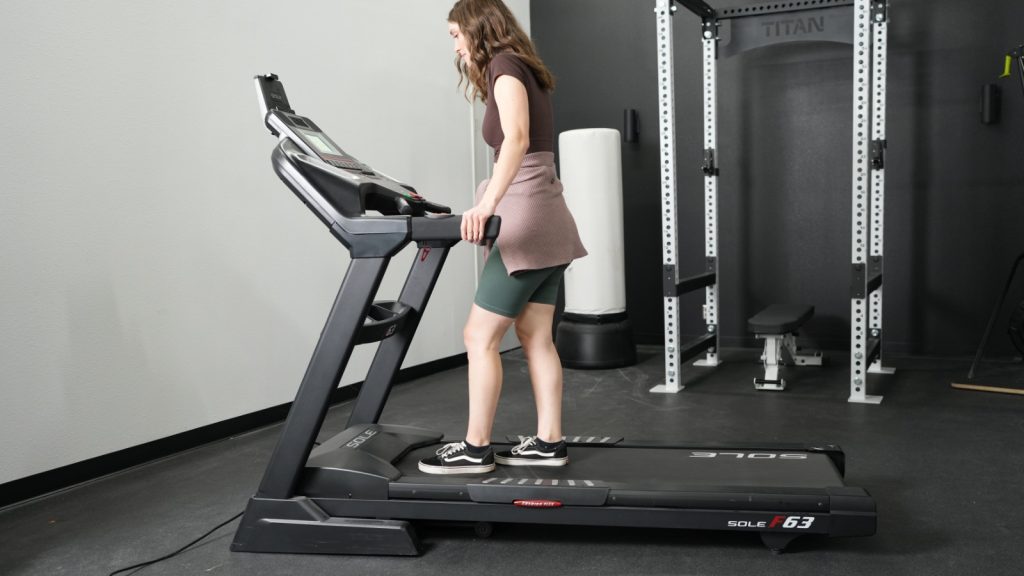
The console comes preloaded with apps like Netflix, Hulu, and Spotify, allowing you to easily stream content while running on the treadmill. There are a variety of preset programs for your training, however, you won’t find any dynamic programming in the vein of IFIT or Peloton.
Its versatility extends to its tech capabilities. A neat feature of the ST90 is the ability to mirror your phone’s screen onto the treadmill’s screen. (It’s worth noting that some customers have complained about connectivity for Android devices.) There’s also a wireless charging pad to keep your phone juiced so that you can focus on the work at hand and not the fact that your phone’s about to die.
Sure, there are transport wheels, but hoisting the thing up is difficult due to the 326-pound weight and lack of a handlebar to hold onto in this tipped position. You’ll also want to set this up in a place where you won’t have to worry about pets and children; the slats in the belt can trap little fingers and paws. However, Sole has included safety features, such as a protective panel on the back of the treadmill, a child lock feature, and sensors that turn the belt off when it detects there’s nobody on the tread after 10 seconds.
Best Non-Folding Treadmill for Athletes: TrueForm Runner
TrueForm Runner
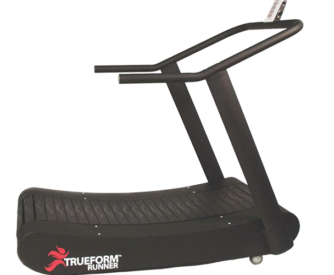
Specs
- Price: $6,899
- Dimensions: 57″ H x 64″ L x 36″ W
- Weight: 350lbs
- Max Speed: NA
- Max Incline: 0%
- Max User Capacity: 450lbs running; 700lbs walking
Pros
- This manual treadmill is great for athletes performing sprint intervals.
- The 450-pound weight limit for running is about 100 to 200 pounds more than the average treadmill we’ve tried.
- The curved tread belt is designed to help improve the user’s running mechanics and form.
Cons
- If the sticker price leaves you shocked, you may want to consider one of the best budget treadmills.
- Our tester was underwhelmed by the display and the few stats it tracks.
- This treadmill weighs 350 pounds, nearly 100 to 150 pounds more than many consumer treadmills.
The TrueForm Runner is built for competitors. This manual treadmill doesn’t have a max speed — because you’re the max speed. Athletes tend to love these types of treadmills because they allow you to accelerate and decelerate at your choosing, unlike typical motorized treadmills that gradually ease from slow to fast and fast to slow. This makes manual treadmills especially useful for performing sprint intervals and building mental toughness.
With a steel frame, a 450-pound weight limit for running, and a 700-pound weight limit for walking, this machine is sturdy enough to support everyone from NFL offensive linemen to sumo wrestlers. That 450-pound weight limit is around 200 pounds more than the average electric treadmill we’ve tried and 100 pounds more than the average manual treadmill.
Durability scored a 5 out of 5 with our expert tester. “This beast has high-end bearings, welded seams, and heavy-duty casters. This frame is truly top-of-the-line,” they said. “It’s got a slightly smaller footprint compared to other manual treadmills I’ve tried, but the frame makes this thing tough to move if you’re not very strong.” For this reason, they gave portability a 3.5 out of 5.
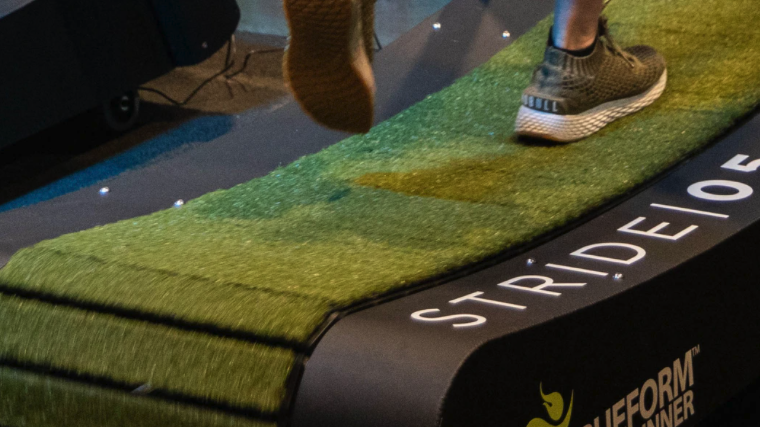
Ergonomics scored a 4.5 out of 5, with our tester noting how this treadmill can aid in improving running form by forcing runners to engage their core and push off the balls of their feet to send the tread backward. Workout experience scored a 4.5 out of 5 as well. The ease with which one can take off at a quick clip is a huge appeal of manual machines like the Runner. “You can go from sprinting to walking, or walking to sprinting, in a few steps,” said our tester.
This is a solid, sturdy, and athlete-focused machine, however, it lacks many of the add-ons and features we see in other treadmills in this price range. “The monitor is… it’s just bad. There are no tech capabilities I can mention and very few stats that get tracked,” said our tester. You’ll also want to look elsewhere if you’re interested in a treadmill with incline or decline capabilities, as this one has none. Tech capabilities scored a 2 out of 5.
Lastly, value scored a 3 out of 5. “This machine is built to last, but it’s got a large price tag,” our tester said. “But I gotta tell you, I love my Runner!”
Read our full TrueForm Runner Treadmill Review.
Best Non-Folding Treadmill with Classes: Peloton Tread
Peloton Tread
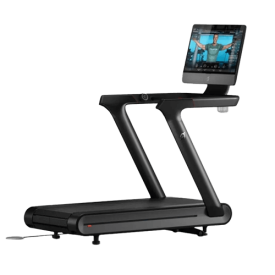
Specs
- Price: $2,995
- Dimensions: 62″ H x 68″ L x 33″ W
- Weight: 290lbs
- Max Speed: 12.5mph
- Max Incline: 12.5%
- Max User Capacity: 300lbs
Pros
- Peloton offers 10+ live workouts everyday and thousands of on-demand classes to choose from.
- The large touch screen helps keep you focused on your class and distracted from the running.
- Community features like leaderboards and virtual high fives allow users to feel connected to others.
Cons
- A monthly $44 subscription fee can be an annoying add-on for some users.
- The 59-inch running belt is shorter than the standard 60-inch we see for treadmills in this price range.
- The frame warranty is only 5 years, 10+ years less than the 15-year-to-life warranty we’ve seen offered by other brands.
The Peloton Tread is like the popular girl in high school: Everyone loves her, and everyone wants to be her. Peloton is renowned for having some of the best music in their classes, with some of the most entertaining and encouraging trainers leading the charge. Matt Wilpers, for example, can provide you with quality cues and insight, while Jess King is a ball of positive energy sure to keep you motivated. With 26 Tread coaches available, dynamic programming and tech capabilities scored a perfect 5 out of 5 with our team.
The intended use of this treadmill is to access one of the best running apps, the Peloton app. Our tester, a certified CrossFit Level 1 coach, has logged over 200 workouts in the app and on the Tread. “This treadmill’s sturdy. I haven’t experienced any shaking with the screen when I’m running,” they said. This is ideal because if you’re buying a Peloton Tread, you’re probably interested in streaming the live and on-demand Peloton classes, and a shaky screen would make for a distracting workout experience. Durability scored a 4 out of 5.
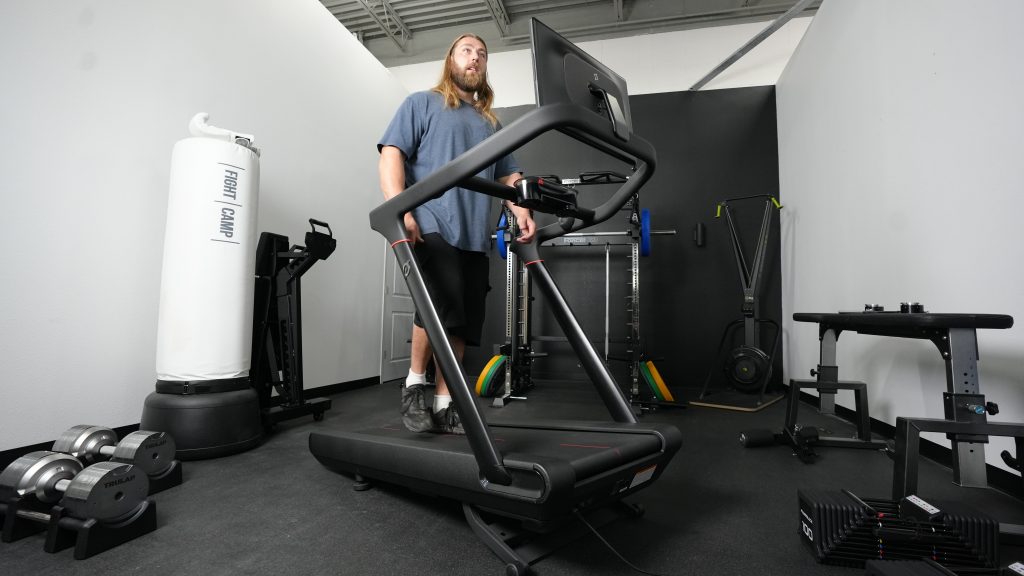
At the head of the treadmill is a 23.8-inch touchscreen, where users can navigate between daily picks, challenges, on-demand workouts, workout history, and classes their friends are currently taking. “The audio quality from the treadmill’s speakers is also really good, it made me feel like I was actually in a real fitness studio,” our tester said, scoring tech capabilities a 5 out of 5.
The running deck is 20 by 59 inches, which is one inch smaller than the standard 60-inch length we see on most treadmills in this price range. But our tester could hardly tell. “I’m fairly tall and I had no problems,” they said. The 5-year frame warranty for the Tread is where Peloton disappoints, as the industry standard is around 15+ years. Warranty scored a 3.5 out of 5.
If you want access to Peloton programming with your Tread, be prepared to pay a $44 monthly subscription fee. If you’ve used the lower-priced $12.99 Peloton App off of your phone, you’ll notice some added features with the higher price tag. With the $44 fee, you’ll be able to give other racers high-fives, compete for positioning on the leaderboard, and join groups based on your experience or interests. These community features are what have made Peloton a leader in the at-home fitness space.
Best Non-Folding Walking Treadmill: Egofit Walker Pro Under Desk Treadmill
Egofit Walker Pro Under Desk Treadmill
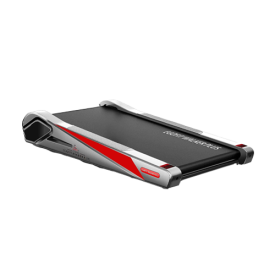
Egofit Walker Pro Under Desk Treadmill
This slim, compact under-desk treadmill takes up less than six square feet of space, making for an excellent fit for athletes working in tight quarters. Plus, we appreciate the pre-assembled design of the Egofit Walker Pro, which eliminates any confusing setup instructions before getting into a walking workout.
Specs
- Price: $399
- Dimensions: 6.9″ H x 38.4″ L x 21.9″ W
- Weight: 48.5lbs
- Max Speed: 3.1mph
- Max Incline: 5% set incline
- Max User Capacity: 242.5lbs
Pros
- At 48.5 pounds, most people can easily carry this treadmill from the office to their home.
- The 5 percent incline gives your legs an added workout while you’re walking at your desk.
- There aren’t any tricky steps for setup. You just plug it in and start walking.
Cons
- The motor on this isn’t strong enough for prolonged or continuous use.
- The 5 miles per hour max is lower than most other treadmills we’ve tried which usually go up to around 10 miles per hour.
- There is no incline adjustment, so if you don’t want to walk at a 5 percent incline, this may not be the right choice for you.
You want the benefits of cardio, even when punched in for your 9-to-5 desk job. The Egofit Walker Pro has a small footprint at 6.9 inches tall, 38.4 inches long, and 21.9 inches wide, making it capable of fitting under most standing desks. At 48.5 pounds, roughly 200 pounds lighter than most of the treadmills we’ve tried, you can also shove it out of the way when your boss walks in. Delivery and setup scored a 5 out of 5, with a 4 out of 5 score for footprint and portability, workout experience, and customer reviews.
If you’re using this at your desk, it needs to have a small profile and it needs to be capable of moving around. Our tester Kate Meier, a certified personal trainer and two-time marathoner, uses this walking treadmill in their home. “It only weighs 48.5 pounds and it comes with transport wheels to move it around. I haven’t had any problem with it and I’ve tried moving it on carpet and hardwood floors,” they said. “It shipped to me fully assembled, so all I had to do was plug it in and I was ready to go.”
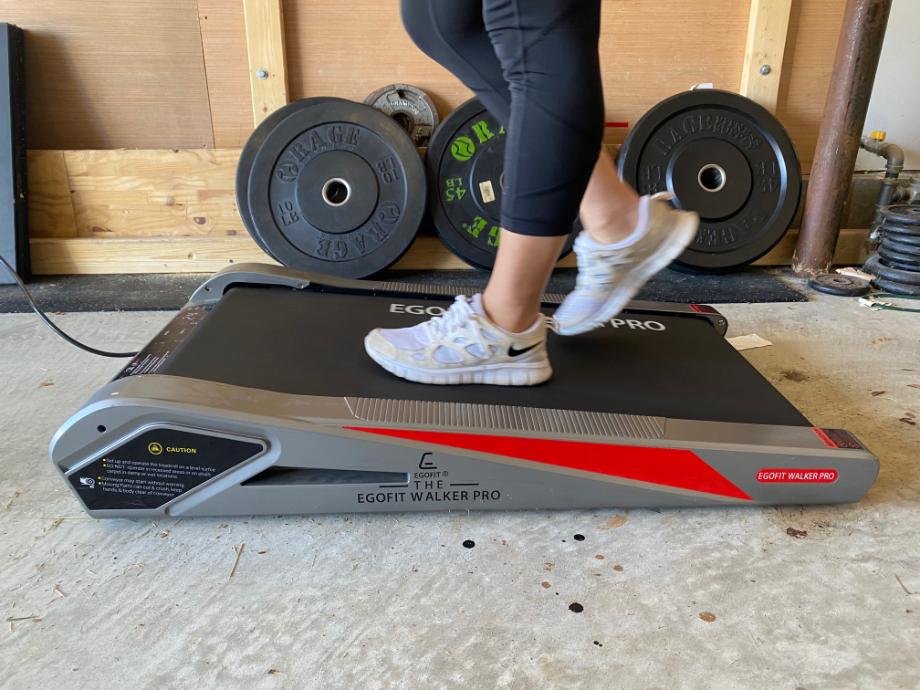
The 0.75 HP motor on this thing and the 245-pound weight limit mean this walking treadmill isn’t suitable for strenuous use. “It’s not something you’ll be able to use every day if you want it to last,” Meier said, “but it does come with lubricant bottles to help maintain the motor.” They gave durability a score of 3.5 out of 5.
If you’ve got a need for speed, you may want to look elsewhere, as the max speed on the Egofit is limited. “The measly 5 miles per hour max isn’t very impressive. I would have liked it if this device could have gone a little faster,” Meier said, scoring customizations a 3.5 out of 5. However, we think those who intend on using this while they work a desk job will find the 5 miles per hour maximum suitable.
Workout experience scored a 4 out of 5 for the ease of use and slight incline. “I didn’t think the 5 percent incline was anything special, but you definitely feel it in your legs after walking on it for a few minutes,” Meier noted. “I worked up a decent sweat with this thing, plus it worked with my long strides which I was concerned about.”
How We Chose the Best Non-Folding Treadmills
Opting for a non-folding treadmill over even the best folding treadmills generally means you’ve got the space for a dedicated cardio playground. You’ll also be privy to increased stability, durability, and intensity of your workout experience with a non-folding option. Our top picks took into account price, adjustability, tech capabilities, durability, and what features were available, among other factors.
Durability
When you’re spending big bucks on a home treadmill, you expect that machine to last. All of the treadmills on our list include components meant to stand the test of time, from strong steel frames to powerful CHP and HP AC motors that you won’t find on many folding treadmills. We also chose options with impressive weight capacities, from 300 to 450 pounds, which is a good clue to tell you how resilient a treadmill will be.
As for our best under-desk option, these treadmills are inherently less durable due to their intended use for walking. Still, we tried to pick a solid option that held up with our tester’s continued use and was priced appropriately.
Price
Non-folding treadmills tend to be more expensive than foldable treadmills due to sturdier construction and the inclusion of more robust (and heavier) motors. If you’re willing to shell out the extra dough, we wanted to be sure that the high-value options on our list earned their price tag. Did it have valuable features such as tech capabilities, a resilient motor, or an increased range of adjustability? These are the features you want in a pricier treadmill.
Features
Whether you’re in the market for cardio machines for weight loss or fitness equipment to improve your marathon time, each treadmill on this list stood out to us for a select feature or features. We wanted to select options with speed and incline capabilities that could give users the type of workout they wanted, whether that was taking off in a sprint as quickly as possible with a manual treadmill or exhausting their glutes with adjustable incline trainers.
Many choices on this list had awesome tech capabilities, impressive workout customizations, commercial-grade motors, and sturdy steel frame construction. Not all treadmills are created equal, so we made sure to highlight the features that each treadmill had.
Benefits of the Best Non-Folding Treadmills
Serious athletes need serious exercise equipment to take their training to the next level. Although these machines are fairly expensive, it’s an investment in yourself, your health, and your future. When compared to folding models, the benefits of this equipment is the longevity users can get from their machines, the durability in build, and the added tech features.
Motor Size
If you want a treadmill that’ll last you through marathon training and multiple users, you’ll want one of the stronger motors that’s generally available in our choices for non-folding treadmills. Look for CHP (continuous horsepower), AC, and DC motors, as these beasts are strong enough to support whatever training you’re looking to do. And when motors didn’t hit the mark, we made sure to note it. As the price increases with a treadmill, the motor is often one of the first things improved upon compared to lower-priced models.
Motorless options can also provide big benefits, as they encourage proper form by forcing the user to engage their core and lead with the ball of their foot to move the tread. This additional effort may also help you burn more calories than you would during a similar session on an electric treadmill. (4)
Stability and Construction
You’re a serious runner and you’re dropping some serious cash, so of course you want your treadmill to keep up with you. The treadmills on our list are sturdy, with many being forged from heavy-duty steel. Lower-priced equipment is often constructed from plastic and aluminum parts, which don’t have the same resilience as steel.
As such, the weight of these machines is often heavier than the folding variations. But with stronger materials comes larger weight capacities, and you’ll find an average 350-pound max weight limit with the best non-folding treadmills.
Tech Capabilities
Since non-folding treadmills tend to be made of tougher stuff than their foldable counterparts, they’re more likely to pack more gadgetry. That often means larger displays with touchscreens, which are helpful for accessing fitness apps like IFIT and Echelon Fit.
If you’re unsure what programming you’re interested in, or if you’re even interested in programming, consider signing up for a trial period so that you can get a feel for the coaches. You’ll also need to decide if you’re willing to pay a monthly subscription fee or if you’d be happier without coach-led training and the extra financial burden.
What to Consider Before Buying a Non-Folding Treadmill
If you want to invest in a non-folding treadmill, be sure to take into consideration exactly what you’re looking for. Do you want a motorized or manual treadmill? Are you looking for something you can move around? How much incline and speed do you need for your training? Take some time to meditate on the key points important to you, so when you come across the features you want, you’ll know it. We’re here to give you some examples of exceptional picks, so use our list as your personal treadmill buying guide and we’ll help you navigate through your options.
Intended Use
If you’re certain you have the dedicated floor space, a non-folding treadmill is a great choice for cardio equipment, as it tends to be more powerful and durable than folding options. However, with the assortment of options out there, you’ll need to know what it is you intend to use the treadmill for.
Are you looking to walk at your desk during the work day? Do you need a treadmill with impressive incline capabilities because you’re training for a rigorous trail run? Keep in mind what you’ll be using this machine for so that you can pick the treadmill that’s right for you.
Manual vs Motor
Taking into account your goals will help you figure out whether or not you want to train with a motorized treadmill or a manual treadmill. Long-distance running and sprint workouts for strength athletes can be accomplished on both of these types of machines. However, manual treadmills can better replicate street running, help to improve running form, and allow the user to change their speed and intensity with their own power, without having to rely on finding the right button on the treadmill’s console.
When opting for a motorized treadmill, make sure that the motor has the power to support your pace. Are you going to be using this treadmill for hours a day, and if so, how will that specific motor hold up over the extended use? HP motors are fine for some walking or occasional light jogging, CHP motors can support those wanting a little more running-focused training, while AC and DC motors will be best suited for more serious runners planning on putting their treadmills to work. Choose the machine with the power that’ll support your goals.
Running Deck
The belt size is often the first thing we look at when determining if a treadmill is capable of making our list. A 20-inch by 60-inch running belt is the general size we recommend for its ability to provide enough space for runners of all heights and gaits. However, many options on the market provide a 50- to 55-inch running deck, which may work perfectly fine for you. You’ll also want to consider the amount of cushioning a running deck provides, especially if you’re someone who needs extra support for your joints.
Final Word
It’s a big decision to bring cardio equipment into your home, from the best exercise bikes to sturdy ellipticals, so take your time to carefully consider your options. Non-folding treadmills are an investment — especially when compared to folding treadmills — but one worth your consideration due to their steel construction, sturdy running experience, and impressive weight capacities. You may not be able to fold these treadmills up and roll them away, but they will last longer and provide more motor power than a folding treadmill.
Take into account your intended use, whether you’re looking to do hill sprints, spend hours training for long distances, or want something that mimics the feel of running on the street. Will you want a motorized treadmill or a manual treadmill? What about the running deck? Do you need the space to pick up your speed, or are you fine with a shorter deck meant for walking? The decision can be stressful, but we aim to support you with the information you need to help you dial in on the treadmill that’s right for you.
FAQs
What is the best non-folding treadmill?
There’s a perfect treadmill out there for everyone, often depending on intended use, budget, and desired features. Our choice for the best non-folding treadmill is the NordicTrack Commercial X22i. This treadmill features an impressive 40 percent max incline, a generous 22-inch by 60-inch running deck, and IFIT compatibility with thousands of coach-led classes.
Are folding treadmills as good as non-folding treadmills?
The short answer is no. Folding treadmills are not as good as non-folding treadmills. But if you don’t have the space and need to be able to move the machine around, a folding treadmill is still a good option. Non-folding treadmills generally provide better construction, which allows for added stability and durability, making them more suitable for serious runners. However, these benefits don’t come cheap, and non-folding treadmills can cost around $2,000 to $4,000 more than the folding variety.
What is a non-folding treadmill?
A non-folding treadmill is a treadmill that can’t be folded up for easy storage, meaning you’re going to want a dedicated place for it in your home gym. They’re heavier than folding treadmills, but that weight is due to sturdy construction and added adjustability for incline, max speed, and tech features.
References
- Hespanhol Junior, L. C., Pillay, J. D., van Mechelen, W., & Verhagen, E. (2015). Meta-Analyses of the Effects of Habitual Running on Indices of Health in Physically Inactive Adults. Sports medicine (Auckland, N.Z.), 45(10), 1455–1468. https://doi.org/10.1007/s40279-015-0359-y
- Vivar, C., Peterson, B., Pinto, A., Janke, E., & van Praag, H. (2023). Running throughout Middle-Age Keeps Old Adult-Born Neurons Wired. eNeuro, 10(5), ENEURO.0084-23.2023. https://doi.org/10.1523/ENEURO.0084-23.2023
- Ahlskog, J. E., Geda, Y. E., Graff-Radford, N. R., & Petersen, R. C. (2011). Physical exercise as a preventive or disease-modifying treatment of dementia and brain aging. Mayo Clinic proceedings, 86(9), 876–884. https://doi.org/10.4065/mcp.2011.0252
- Edwards, R. B., Tofari, P. J., Cormack, S. J., & Whyte, D. G. (2017). Non-motorized Treadmill Running Is Associated with Higher Cardiometabolic Demands Compared with Overground and Motorized Treadmill Running. Frontiers in physiology, 8, 914. https://doi.org/10.3389/fphys.2017.00914
The post The 6 Best Tried and Tested Non-Folding Treadmills of 2024 appeared first on BarBend.

